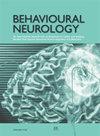Ga-Young Kim, HyangHee Kim, Hee Jin Kim, Sang Won Seo, Duk L Na, Chung Mo Nam, Byoung Seok Ye, Il Joon Moon
下载PDF
{"title":"遗忘性轻度认知障碍患者的中枢性听觉加工障碍。","authors":"Ga-Young Kim, HyangHee Kim, Hee Jin Kim, Sang Won Seo, Duk L Na, Chung Mo Nam, Byoung Seok Ye, Il Joon Moon","doi":"10.1155/2022/9001662","DOIUrl":null,"url":null,"abstract":"<p><strong>Background: </strong>This study was conducted to comprehensively examine the central auditory processing (CAP) abilities of patients with amnestic mild cognitive impairment (aMCI) as well as to compare the results with cognitively normal elderly controls.</p><p><strong>Methods: </strong>A total of 78 participants were screened through pure-tone audiometry and word recognition score in order to exclude peripheral auditory dysfunction. Forty-five people passed screening tests, and 33 people failed. Finally, 25 aMCI (mean age = 71.52 ± 4.8; male : female = 24 : 76) and 20 controls (mean age = 73.45 ± 4.32; male : female = 45 : 55) were enrolled in the study. Seven CAP tests (frequency pattern test, duration pattern test, Gap-In-Noise<sup>©</sup> test, dichotic digits test, low-pass filtered word test, speech perception in noise test, and binaural fusion test) were conducted only after the two groups passed the screening. A linear mixed model was applied to analyze CAP tests except for the binaural fusion test. For the binaural fusion test, the independent <i>t</i>-test was used to compare the means of test score between two groups.</p><p><strong>Results: </strong>The aMCI group had a decrease in the mean score of the frequency pattern test, duration pattern test, Gaps-In-Noise<sup>©</sup> test, dichotic digits test, and speech perception in noise test compared with the control group.</p><p><strong>Conclusion: </strong>The aMCI group's CAP abilities were significantly lower than those of the control group. Thus, if the cognitive assessment and hearing evaluation are conducted in combination, the sensitivity of the diagnostic process for aMCI will be increased.</p>","PeriodicalId":50733,"journal":{"name":"Behavioural Neurology","volume":"2022 ","pages":"9001662"},"PeriodicalIF":2.3000,"publicationDate":"2022-01-01","publicationTypes":"Journal Article","fieldsOfStudy":null,"isOpenAccess":false,"openAccessPdf":"https://www.ncbi.nlm.nih.gov/pmc/articles/PMC9779989/pdf/","citationCount":"0","resultStr":"{\"title\":\"Central Auditory Processing Disorder in Patients with Amnestic Mild Cognitive Impairment.\",\"authors\":\"Ga-Young Kim, HyangHee Kim, Hee Jin Kim, Sang Won Seo, Duk L Na, Chung Mo Nam, Byoung Seok Ye, Il Joon Moon\",\"doi\":\"10.1155/2022/9001662\",\"DOIUrl\":null,\"url\":null,\"abstract\":\"<p><strong>Background: </strong>This study was conducted to comprehensively examine the central auditory processing (CAP) abilities of patients with amnestic mild cognitive impairment (aMCI) as well as to compare the results with cognitively normal elderly controls.</p><p><strong>Methods: </strong>A total of 78 participants were screened through pure-tone audiometry and word recognition score in order to exclude peripheral auditory dysfunction. Forty-five people passed screening tests, and 33 people failed. Finally, 25 aMCI (mean age = 71.52 ± 4.8; male : female = 24 : 76) and 20 controls (mean age = 73.45 ± 4.32; male : female = 45 : 55) were enrolled in the study. Seven CAP tests (frequency pattern test, duration pattern test, Gap-In-Noise<sup>©</sup> test, dichotic digits test, low-pass filtered word test, speech perception in noise test, and binaural fusion test) were conducted only after the two groups passed the screening. A linear mixed model was applied to analyze CAP tests except for the binaural fusion test. For the binaural fusion test, the independent <i>t</i>-test was used to compare the means of test score between two groups.</p><p><strong>Results: </strong>The aMCI group had a decrease in the mean score of the frequency pattern test, duration pattern test, Gaps-In-Noise<sup>©</sup> test, dichotic digits test, and speech perception in noise test compared with the control group.</p><p><strong>Conclusion: </strong>The aMCI group's CAP abilities were significantly lower than those of the control group. Thus, if the cognitive assessment and hearing evaluation are conducted in combination, the sensitivity of the diagnostic process for aMCI will be increased.</p>\",\"PeriodicalId\":50733,\"journal\":{\"name\":\"Behavioural Neurology\",\"volume\":\"2022 \",\"pages\":\"9001662\"},\"PeriodicalIF\":2.3000,\"publicationDate\":\"2022-01-01\",\"publicationTypes\":\"Journal Article\",\"fieldsOfStudy\":null,\"isOpenAccess\":false,\"openAccessPdf\":\"https://www.ncbi.nlm.nih.gov/pmc/articles/PMC9779989/pdf/\",\"citationCount\":\"0\",\"resultStr\":null,\"platform\":\"Semanticscholar\",\"paperid\":null,\"PeriodicalName\":\"Behavioural Neurology\",\"FirstCategoryId\":\"3\",\"ListUrlMain\":\"https://doi.org/10.1155/2022/9001662\",\"RegionNum\":4,\"RegionCategory\":\"医学\",\"ArticlePicture\":[],\"TitleCN\":null,\"AbstractTextCN\":null,\"PMCID\":null,\"EPubDate\":\"\",\"PubModel\":\"\",\"JCR\":\"Q2\",\"JCRName\":\"CLINICAL NEUROLOGY\",\"Score\":null,\"Total\":0}","platform":"Semanticscholar","paperid":null,"PeriodicalName":"Behavioural Neurology","FirstCategoryId":"3","ListUrlMain":"https://doi.org/10.1155/2022/9001662","RegionNum":4,"RegionCategory":"医学","ArticlePicture":[],"TitleCN":null,"AbstractTextCN":null,"PMCID":null,"EPubDate":"","PubModel":"","JCR":"Q2","JCRName":"CLINICAL NEUROLOGY","Score":null,"Total":0}
引用次数: 0
引用
批量引用
Central Auditory Processing Disorder in Patients with Amnestic Mild Cognitive Impairment.
Background: This study was conducted to comprehensively examine the central auditory processing (CAP) abilities of patients with amnestic mild cognitive impairment (aMCI) as well as to compare the results with cognitively normal elderly controls.
Methods: A total of 78 participants were screened through pure-tone audiometry and word recognition score in order to exclude peripheral auditory dysfunction. Forty-five people passed screening tests, and 33 people failed. Finally, 25 aMCI (mean age = 71.52 ± 4.8; male : female = 24 : 76) and 20 controls (mean age = 73.45 ± 4.32; male : female = 45 : 55) were enrolled in the study. Seven CAP tests (frequency pattern test, duration pattern test, Gap-In-Noise© test, dichotic digits test, low-pass filtered word test, speech perception in noise test, and binaural fusion test) were conducted only after the two groups passed the screening. A linear mixed model was applied to analyze CAP tests except for the binaural fusion test. For the binaural fusion test, the independent t -test was used to compare the means of test score between two groups.
Results: The aMCI group had a decrease in the mean score of the frequency pattern test, duration pattern test, Gaps-In-Noise© test, dichotic digits test, and speech perception in noise test compared with the control group.
Conclusion: The aMCI group's CAP abilities were significantly lower than those of the control group. Thus, if the cognitive assessment and hearing evaluation are conducted in combination, the sensitivity of the diagnostic process for aMCI will be increased.

 求助内容:
求助内容: 应助结果提醒方式:
应助结果提醒方式:


